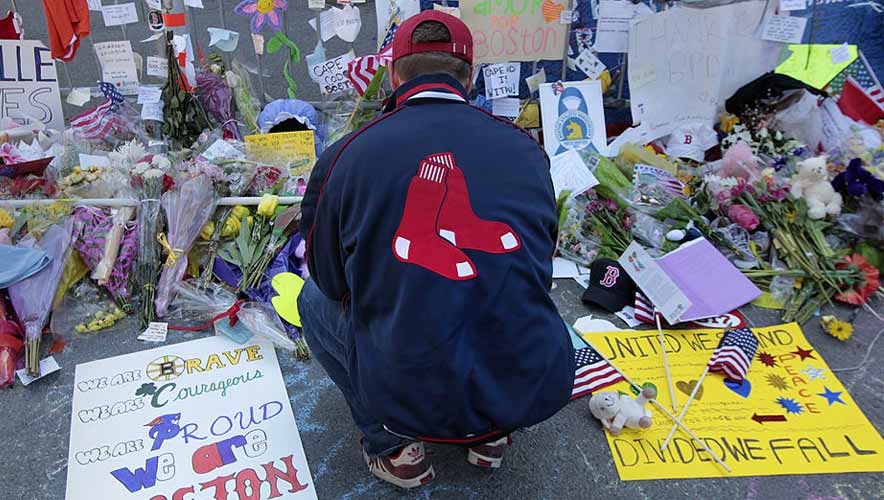Swarm: The Leadership Style that Led an Effective Response to the Boston Marathon Bombing
When the second bomb detonated on 13 April 2013 near the finish line of the Boston Marathon bombing, Superintendent-in-Chief of the Boston Police Department Daniel Linskey was in his patrol car and his radio went off.
One of his cops, Sergeant Dan Keeler, was broadcasting at a level that was nearly unintelligible. “This is 984! Multiple explosions on Boylston!” Keeler yelled. And Linskey knew that if Keeler was shouting like that on the radio, something was really, really wrong.
Linskey rushed in his car towards the finish line of the marathon where he knew Keeler was stationed. Meanwhile, Keeler stepped up to run the scene for the first few minutes, ensuring that the critical response measure of keeping streets open so ambulances could make their way through occurred.
When Linskey arrived on Boylston Street shortly after the blasts and saw the carnage, he was overwhelmed and angry. Then, he took a deep breath and started giving orders on his radio to take charge of the scene. He ordered police vans to be used to load up three injured people at a time with one medic in the back and head to a hospital.
Linskey remembered his training and that as a leader, he needed to define what the five most important actions were right now and to communicate those priorities to his officers in a clear voice. First, treat and triage the patients. Second, get the incident command post set up. Third, clear the street. Fourth, conduct an explosives ordinance sweep. Fifth, evacuate the restaurants and bars in the immediate area.
“You better be the calmest and coolest in your entire career when you get on that radio,” Linskey says in an interview with Security Management 10 years after the incident. “Tell them what you want in a clear, calm direction.”
Those decisive commands helped spur a response that led to every single injured person evacuated from the scene surviving the bombing. That tone had been honed over the years in responding to all kinds of incidents throughout Linskey’s lengthy career in the Boston Police Department—which began when he was just 19 years old, when he was the youngest cop in Boston history.
Throughout his law enforcement career—starting as a cop on narcotics, hostage negotiation, and protective details before becoming head of the Municipal Police Department and then superintendent-in-chief of the Boston Police Department, Linskey had learned how to interact with his peers and direct reports on the force. He learned how to check in with his officers and also train them to respond when a crisis occurred. Meanwhile he built relationships with other key agency personnel that would respond should disaster strike in Boston.
All of that came together in the Boston Marathon bombing incident response, which is largely considered a success due in part to the effective leadership in managing the incident.
You better be the calmest and coolest in your entire career when you get on that radio.
In testimony before Congress on the 10th anniversary of the bombing in April 2023, Richard Serino, deputy administrator of the Federal Emergency Management Agency (FEMA) from 2009 to 2014 and former chief of Boston Emergency Medical Services (EMS), said this effective leadership started at the top with Boston Mayor Tom Menino and Massachusetts Governor Deval Patrick and continued throughout its agencies.
“Mayor Menino and Governor Patrick set the tone long before the bombing in stressing the importance of preparing, practicing, and cooperating with compassion for disasters,” Serino said. “Both leaders demonstrated the best of servant leadership and allowed their teams to function at their highest level for the greater good.”
After the initial recovery period from the Boston Marathon bombing was over, Serino—who is now a distinguished senior fellow at the National Preparedness Leadership Initiative at Harvard University—began studying the leadership style present in Boston during the crisis. Serino called together leaders, including Linskey, to review what happened and how they reacted. Their leadership style differed drastically from other disaster responses because the other incidents had a clear, identifiable leader in charge of the overall operation, Serino and his co-researchers Leonard Marcus and Eric McNulty wrote in a 2017 paper.
In comparison, the marathon route runs through eight localities and is also a Massachusetts state event. The act of terrorism was a federal crime. This meant that agencies at all levels were involved in the response, with no single assumed leader for the entire operation.
“It astonished us that despite this anomaly, the response achieved its overriding objectives,” the researchers wrote. “Though three people were instantly killed by the blasts, all 264 people injured—many with life threatening injuries—survived. That was no accident. A lot of leadership generated that result. The investigation and manhunt were successfully completed in 102 hours. And under the banner of ‘Boston Strong,’ the city was truly resilient.”
How did Boston’s leaders achieve this outcome? The researchers looked to “swarm intelligence,” a field that looks at how insects (bees, ants, and termites) accomplish complex tasks to achieve their goals without an overarching singular direction.
“The key to their successes are instinctual adherence to shared rules and principles along with clear lines of communication and structure,” the researchers explained.
They ultimately defined this leadership style as “swarm leadership,” which has five aspects:
- Unity of mission.
- The generosity of spirit and action.
- Stay in your lane, do your job, and help others succeed.
- No ego—no blame. No one takes credit for their success together. No one points fingers when problems arose.
- A foundation of trusting relationships—leaders know and have confidence in one another.
There are numerous examples in the timeline of events in responding to the Boston Marathon that showcased this leadership style, as well as key behaviors in the lead-up to the incident. For instance, in the After Action Report for the Response to the 2013 Boston Marathon Bombings, a review committee found that pre-existing relationships among local, state, and federal leadership enhanced their capabilities and capacity to effectively respond to the incident.
“These relationships built the trust and rapport that allowed for unified command (UC) to come together organically and quickly and supported timely, effective, and collaborative decision making,” the after-action report concluded. “These relationships also allowed leadership to call for resources, task missions, mobilize mutual aid, and coordinate communications effectively. It took just a few calls or personal conversations among senior leadership to obtain approval and arrange assistance for many aspects of the response.”
One specific example of this playing out in the bombing response was when local authorities were preparing for U.S. President Barack Obama to visit Boston to meet with victims and their families. Linskey realized their canine teams were exhausted—having screened hundreds of abandoned items at the bombing scene and responded to at least 61 calls for suspicious packages in the hours after the bombing—and could not perform the sweeps the U.S. Secret Service required before a presidential visit.
Tom Minor, a colonel in the U.S. Air Force who was a classmate of Linskey’s at the FBI National Academy (a 10-week training program for law enforcement leaders), had texted Linskey to let him know Minor was thinking of him and to call on him if he could be of help in the response. Linskey took him up on his offer, and asked if there was any way Minor could send some canine and handler teams to help prepare for the presidential visit.
Minor had to tell Linskey that technically, he could not send the teams due to restrictions on military aid to domestic law enforcement. He could, however, send 50 dogs and handlers to support protection measures for the U.S. president—the commander-in-chief of the U.S. military.
“He went around his procedure and gave me a solution,” Linskey recalls.
Ultimately, Boston received reinforcements for explosives ordinance teams from Connecticut State Police, the FBI, the New Hampshire State Police, Rhode Island State Police, the U.S. Air Force, and the U.S. Navy. And due to their training and past experiences of working together, these teams “smoothly integrated,” according to the after-action report.
That particular response demonstrated a swarm instinct, when leaders look for and then act on opportunities for informal, strategic collaboration.
“This is particularly important when the task at hand requires active participation by different departments, organizations, or jurisdictions,” the researchers explained. “While each of these entities retains responsibility for their own lines of authority, they tend to collaborate with less attention to who is in charge and more focus on getting the job done, especially when lives are at stake.”
In his congressional testimony, Serino said we “saw phenomenal coordination of leadership across agencies, with everyone working together in their respective silos or as we call them ‘cylinders of excellence.’”
Since the bombing, the Harvard National Preparedness Leadership Initiative has created a curriculum based on swarm leadership principles to train current and future leaders to respond to emergencies.
Those principles have played out in responding to subsequent crises, like Hurricane Harvey in 2017 when an informal network of boat owners organized to rescue people stranded in their homes and cars in and around Houston, Texas. The group called itself the Cajun Navy and operated like a swarm.
The leadership initiative also partnered with an unnamed company in Houston, whose leaders were trained on the swarm leadership principles and put them into action as part of the Harvey response.
That was no accident. A lot of leadership generated that result.
“Those practices emerged as the company rallied to save and support numerous employees and families stranded in the watery murk,” the researchers explained. “Theirs was not a Navy but an Army of volunteers who set up a temporary shelter for houseless employees, a call-in center that gathered and relayed information when the city’s 911 system became nearly paralyzed, and a volunteer network to assist employees whose homes were destroyed. This spontaneous and informal network sprung up alongside the company’s formal crisis infrastructure, allowing them to respond on a scale that otherwise was unattainable.”
Speaking to Linskey about the marathon bombing response, he says the incident reinforced his leadership style and continues to influence how he approaches his work today.
“I want to keep that going forward—being collaborative and knowing ahead of time, leading from the front,” adds Linskey, who is now a managing director in Kroll’s Security Risk Management practice.
Continuing to use swarm leadership style also means that leaders set the stage for their colleagues—and fellow officers—to step up when the moment presents itself. As a security director and police leader, doing that job is one role, he explains. More important is building a team of leaders behind you who are better than you.
“Part of being a boss is building a transition plan that’s just as good if not better than you,” he adds. “You owe it to your team that when that bomb goes off they don’t ask ‘who’s in charge?’ If I haven’t provided my team with the knowledge, skills, and the mission, I’ve failed. You have to enable them and show you don’t have to wait. Take initiative. Have someone ready to step and lead through that crisis.”
Megan Gates is senior editor of Security Management. Connect with her at [email protected] or on LinkedIn. Follow her on Twitter: @mgngates.












